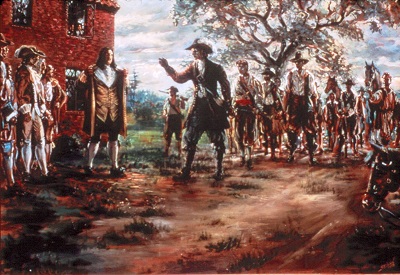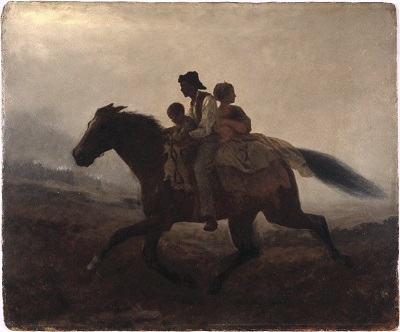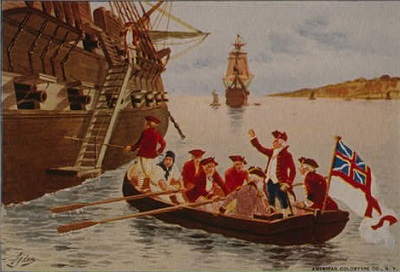Civil Unrest

NPS; Sidney King, artist
In the hundred years leading up to the Revolutionary War, there was a lot of unrest among the settlers. Tobacco prices kept fluctuating. Commercial competition with Maryland and the Carolinas was growing. The English had faced many naval loses in the wars with the Dutch. Harsh weather destroyed the crops. Mercantilism, a system of government controlled trade, had restricted the English markets. Frontier planters, those that were farther away from the Jamestown settlement, felt that planters near the governor were receiving special privileges. All these factors frustrated the colonists. Tensions were high. After the Doeg tribe raided Thomas Mathew's plantation in July 1675, the colonists attacked. The colonists attacked the wrong group, causing the Sesquehanaugh tribe to start raiding. To prevent future attacks, Governor Berkeley ordered an investigation. He set up a meeting, which resulted in the murder of several tribal chiefs. Although the governor urged the colonists to be peaceful, some refused. Governor Berkeley wanted to preserve the friendship with Native Americans. He also wanted to assure the colonists that the Native Americans were not hostile. His first action was to take away the Native American's gunpowder and ammunition. To meet his second goal, Governor Berkeley called the Long Assembly in March 1676. The assembly declared war on all hostile Native Americans. This led to wars with the Native Americans and caused an increase in taxes to help pay for the army. The assembly ordered forts, such as Fort Boykin, to be built of the frontier. This was to establish a defensive zone around the colony. The assembly also ruled that traders could no longer independently trade with Native Americans. A commission was established to track trade. The commission wanted to prevent Native Americans from trading for guns and ammunition.
Nathaniel Bacon, a distant cousin of the governor, was affected by the governor's orders. Bacon publicly accused Governor Berkeley of playing favorites. After Bacon drove the Pamunkey's from their lands, Berkeley rode to Bacon's headquarters. He arrived with 300 well-armed gentlemen. Bacon and 200 of his men fled into the woods in search of a better meeting place. Governor Berkeley ordered two petitions, the first declared Bacon to be a rebel. The second pardoned Bacon's men if they went home peacefully. Bacon responded by attacking the friendly Occaneechee tribe on the Roanoke River. Governor Berkeley agreed to pardon Bacon if he turned himself so that he could be tried in front of King Charles II. The House of Burgesses rejected his alternative and insisted that Bacon beg for forgiveness. Ironically, local landowners elected Bacon to the House of Burgesses. When Bacon went to attend the Assembly in June 1676 he was captured and forced to apologize. Berkeley immediately pardoned Bacon and allowed him to take his seat. On June 30, Bacon issued the "Declaration of the People." In this declaration, Bacon accused Berkeley of being corrupt and for protecting the Native Americans. After months of conflict, Bacon led 300-500 men to Jamestown. On September 19, 1676 they burned Jamestown to the ground. Governor Berkeley retreated across the James River. Before a naval squadron could arrive to aid Berkeley, Bacon died suddenly from disease on October 26. After Bacon's death, Governor Berkeley regained control. Berkeley executed twenty-three major leaders of the rebellion without trial. After an investigation report was issued to King Charles II, Governor Berkeley was relieved of his position. Berkeley returned to England where he died in July 1677. Bacon's rebellion is considered one of the earliest large scale rebellions in American history. Bacon's Castle was named for the rebel, Nathaniel Bacon.
Slave Resistance

Courtesy of Brooklyn Museum; Eastman Johnson, artist
Resistance among the enslaved population in Virginia posed an additional threat and challenge to plantation owners. It was a natural response to slavery. Enslaved persons were not treated like humans. They were considered to be savages and uncivilized. Their dark skin and woolly hair did not fit into the European ideals of beauty and civilization. They were seen as replaceable animals to be used for their labor. They were forced to work long hours, with little food and comfort. They were abused and beaten. They were ripped from their families at a moment’s notice. Resistance took on a variety of forms.
Some of the less violent forms included poisoning animals, acting sick, breaking tools, or slowing down production. Enslaved persons also stole food, livestock, tobacco, liquor, and money. Theft of food was common and usually justified. Slave rations were typically inadequate and failed to provide proper nutrition.Other forms of resistance were more direct. This could include running away. The more violent forms of resistance were uprisings.
Before the 1800s there were no successful uprisings in Virginia.This was due to a variety of factors. Until the 1700s there were not enough slaves in Virginia to form a real threat to the colonists. For instance, in 1625 there were only 23 slaves in the colony. By 1650, there were 300. Many of the enslaved were illiterate and did not share a common language. Since the enslaved could not communicate with each other, they could not band together. The distance between large plantations also made meeting difficult. The plots that were planned were uncovered before they could be carried out. One example occurred in the 1660s. Enslaved Africans and white indentured servants plotted to murder their masters. Not much else is known about this plot, except that an indentured servant, Berekenhead, outed the conspirators. For telling, Berkenhead received five thousand pounds of tobacco and his freedom. Those involved received a bloody warning as several heads were hung from a local chimney. In 1687 a widespread conspiracy was crushed. Authorities learned that the plotting took place at slave funerals and forbid them.
By the early 1800s, conditions had changed. Import of slaves from Africa ended in 1808. Most of Virginia's slaves were native rather than foreign born. Communication was easy. They knew the surrounding areas and knew the habits and customs of their masters. In 1831, Nat Turner led the first successful, and most famous, slave rebellion in Southampton County, Virginia. On August 21, 1831 Turner and a group of men killed the family of Joseph Travis. Turner had been a slave on Travis’ farm for over a year. Turner and his men then moved through the county, killing every white person they encountered. They stole money, supplies, and firearms. By the time white inhabitants of Southampton were notified, Turner had a group of 50 or 60 men. Five of them were free black men. On August 22, there was a battle between Turner’s men and white Southern men. When the battle ended 55 white people had been killed. Turner was able to escape and hid out Southhampton County for six weeks. He was eventually captured. On November 11, Turner and 16 of his followers were sentenced to death by hanging. Nat Turner’s Rebellion frightened white southerners because it challenged the idea that slavery was a benevolent act. Slave owners often thought of themselves as kind and well-intentioned masters. They believed that they were saving the lives of the slaves by providing them with civilization and religion. Turner’s rebellion demonstrated that the slaves wanted to be free. It also showed white Southerners that their Christian beliefs went against the institution of slavery. As a result of the rebellion, the Virginia General Assembly debated the future of slavery in Virginia the following spring. The future of slavery would be decided in the American Civil War.
American Revolutionary War

Courtesy of Library of Congress
When the American Revolution began, Virginia was the largest and most populous British colony. Lord Dunmore had been governor of Virginia since 1771. Tensions were already high in Virginia when the first shots were fired at Lexington and Concord. The Patriots began recruiting troops in March 1775. Patriots were the people who wanted the American colonies to gain their independence from Britain. They believed they were being treated unfairly by the British and taxed without representation in the government. The Patriots were in a constant struggle for military supplies with the Loyalists. The Loyalists were those who wanted to stay a part of Britain and remain British citizens. Lord Dunmore ordered the Loyalists to remove gunpowder from storage warehouses in Williamsburg. This resulted in a small militia uprisings. It was resolved quickly, but Lord Dunmore feared for his life. He left Williamsburg in June 1775 and boarded a Royal Navy Ship in Norfolk with his family. Small skirmishes and confrontations took place between the Patriots and Loyalists until October. At the end of October, the Patriots captured a small British ship.
On November 7, 1775, Lord Dunmore issued a proclamation. Lord Dunmore’s Proclamation offered freedom to any slave who abandoned their master to join the British. The Continental Army (American army) did not accept slaves until 1776. Lord Dunmore organized these men into his Ethiopian Regiment. Dunmore and the Loyalists realized that by recruiting slaves they could cause an uprising. Dunmore’s army won the Battle of Kemp’s Landing on November 17, 1775. They lost the Battle of Great Bridge on December 9th. This battle was significant because it eliminated British authority in the colony. The Battle of Great Bridge was one of the earliest, smallest, shortest, and least known battles of the American Revolution. Less than 300 men engaged in battle that lasted less than five minutes. After the battle was over, Lord Dunmore retreated to Norfolk, and eventually returned to England. He was the last Royal Governor.
On January 1, 1776 the Patriots captured Norfolk. Royal Navy Ships anchored in the harbor began shelling the town. Small boats were sent ashore to burn Loyalist properties that were being used by snipers to fire upon the British fleet. Since the Patriots could not stop the Navy ships, they began burning and looting Loyalist properties. After three days, most of the town was destroyed. The Patriots destroyed 863 properties compared to the 19 properties destroyed by the Loyalists. This event is known as the Burning of Norfolk.
By 1781, the Revolutionary war was entering its eighth year. The national currency was worthless. The Continental Army had suffered major defeats to the British army. Public support for the army was dropping. Army troops were becoming mutinous over pay and conditions. To counter the British threat from the south, General Washington sent Major Nathanael Greene to rebuild the army in North Carolina. British General Cornwallis wanted to gain control over the state and weaken Major Greene’s army. Brigadier General Benedict Arnold was sent by the British in December 1780 to destroy the Continental Army’s supplies and storage depots. Arnold is famous for being a traitor. He switched sides during the war because he was concerned that the colonies were doomed. Arnold and his 1,600 men were used as a diversion to draw attention and resources away from General Greene.
On January 4, 1781, Arnold sailed up the James River and landed at Westover. After an overnight march, Arnold and his men raided Richmond and then returned to Portsmouth. Once they reached Portsmouth they fortified the city. General Washington mobilized land and naval forces in response to Arnold’s arrival in Portsmouth.In March 1781, Major General William Phillips landed along the James River with 2,500 men. On March 26, General Phillips took command of the forces, including Arnold’s men. Patriot Major General Baron von Steuben gathered 1,200 men at Petersburg, an important supply center. On April 25, General Phillips attacked Petersburg from the east, near a small community known as Blanford. After three hours of fighting, General von Steuben retreated to Richmond where he joined forces with the Continental Army. General von Steuben had successfully succeeded in forcing the British to fight for Petersburg. This confrontation is known as the Battle of Blanford.
Several months later the American Revolutionary War ended with the Siege of Yorktown. General Washington led a combined French and American army in a successful attack on the British. American independence was finally secured.
Last updated: September 15, 2016
